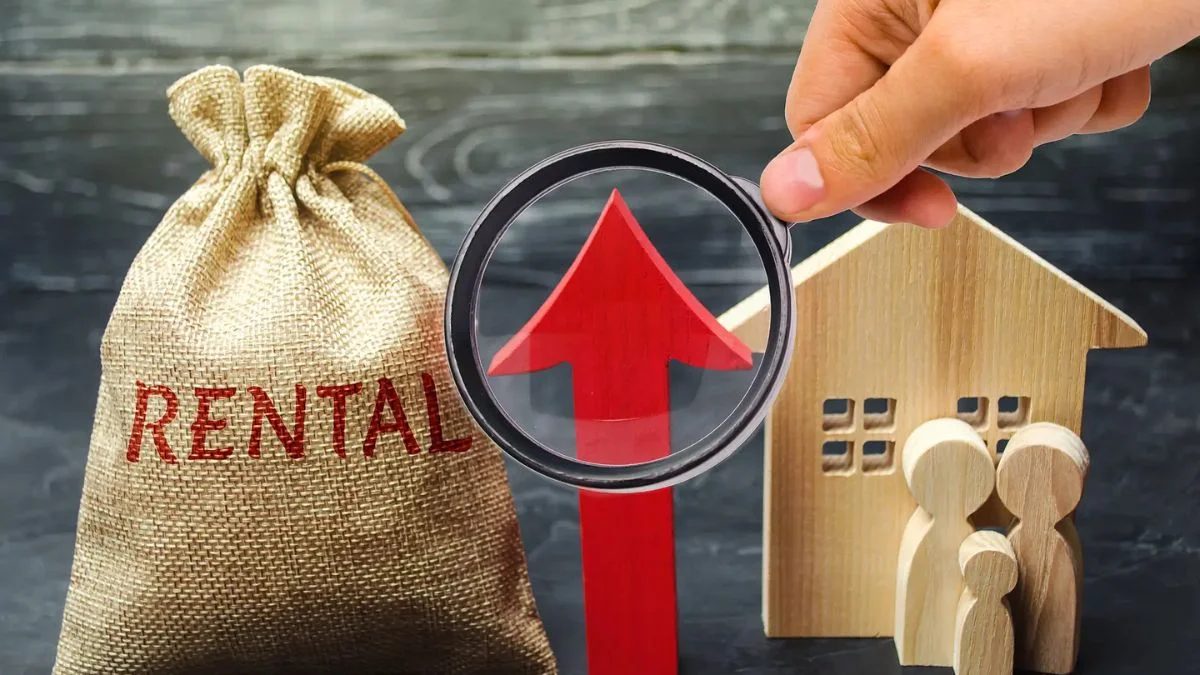Every year, landlords face the same balancing act, keeping rent aligned with rising costs while staying fair to good tenants. Setting the right rent increase is more than just matching inflation. It’s about understanding market data, legal limits, and long-term profitability.
This 2025 guide explains what the average rent increase per year looks like across the U.S., why rent goes up, how much you can legally raise it, and how to communicate that change effectively.
Why Do Rents Increase Every Year?

A common question among new landlords is, "Does rent increase every year?" The short answer is yes, typically by around 3% to 5% annually. This steady rise happens for several clear reasons: increasing property taxes, maintenance expenses, insurance costs, and overall inflation.
Common Economic Factors (Inflation, Demand/Supply)
Inflation remains one of the strongest drivers of annual rent increases. According to the U.S. Consumer Price Index (CPI) rose in 2024 was 2.9%, pushing up nearly every operational expense a landlord faces, from maintenance to materials.
If property taxes, insurance, and utility costs climb by 5%, but rent stays flat, profits decline in real terms. Adjusting rent by at least the inflation rate helps maintain sustainable cash flow without overburdening tenants.
Market Cycles and Seasonal Demand
The rental market operates in cycles. Increases are often seasonal, with many landlords choosing to raise the rent during the peak summer months when tenant competition is highest. Furthermore, local economic booms (new job opportunities, company relocations) can cause immediate, steep increases in the local rental rate.
For example, iIn high-demand areas like Austin, Miami, and Nashville, strong population growth has pushed rents upward faster than the national average. Meanwhile, cities such as San Francisco and Seattle saw moderate or even declining rent growth in 2023–2024 due to new apartment construction and migration shifts.
Maintenance, Taxes and Other Landlord Costs
Your operating expenses are constantly climbing. Landlords see increases in:
- Property Taxes: These can rise annually based on local assessments.
- Maintenance and Repairs: The cost of labor and materials for general upkeep and major repairs increases with inflation.
- Utilities: If you cover any utilities, those costs are passed on through the rent.
To cover these growing expenses and protect your rental property cash flow, an annual rent increase is necessary.
Insurance Premiums and Local Fees
In 2024, landlord insurance premiums rose by 6–9% nationwide, especially in coastal and wildfire-prone areas. Many cities have also raised inspection and registration fees. These factors directly impact the average rent increase per year, especially for small-scale landlords managing just one or two properties.
In summary, annual rent increases—typically around 3% to 5% are driven by inflation, rising taxes, insurance, and maintenance costs. Keeping rent aligned with these changes helps landlords protect cash flow while staying competitive and fair in the market.
Next, let’s look at the average rent increase per year across the U.S. and how current trends compare to inflation and past years.
What Is the Average Rent Increase Per Year in the U.S.?
Understanding national benchmarks gives you a starting point for determining what is the average rent increase per year.
National Averages Over the Last 5–10 Years
Historically, the average rent increase per year in the U.S. has averaged around 3% to 5% annually in stable market conditions. This range is often seen as a reasonable way to offset inflation and rising operating costs.
The table below summarizes the national rent growth trends over recent years, highlighting how market conditions have evolved:
Annual Rental Increase Percentage Trends
In 2025, data suggests the national average rent increase will fall closer to the 5% mark, though some forecasts range higher based on unit size and location.
Landlords in high-demand, high cost-of-living areas (like parts of California, New York, or high-growth Southern cities) may see market support for increases nearing the legal maximum.
Rent vs. Inflation: Are Landlords Keeping Up?
For many years, rental growth typically tracked slightly ahead of the Consumer Price Index (CPI), which measures inflation. However, the last few years have seen significant volatility.
While rent prices soared after 2021, many landlords are still trying to catch up on the cumulative effect of rising property taxes and repair costs. A rent raise percentage that falls below the local inflation rate can lead to diminished property returns over time.
How Much Can You Legally Raise Rent in 2025?

The amount a landlord can legally raise rent in 2025 depends largely on state rent laws and whether your property is under rent control or in a free market area. While national rent averages may suggest a 3%–5% annual increase, your local laws ultimately decide how much rent can go up in a year.
In general, rent increases must comply with legal caps, notice requirements, and tenant protection laws. To stay compliant, review your local regulations or visit how much can the landlord raise rent for a full breakdown by state.
Rent Control vs. Free Market States
The biggest factor is whether your property is in a state or municipality with rent control laws.
- Rent Control/Stabilization: Jurisdictions with these laws (e.g., New York City, certain areas of California, Oregon) impose strict limits on how much rent increase per year is allowed. These caps are often tied to the local Consumer Price Index (CPI) plus a set percentage.
- Free Market States: Most states have no statewide cap on rent increases. In these areas, the only limits are determined by the lease agreement and non-discriminatory, non-retaliatory practices.
State-by-State Legal Limits on Rent Increases
Every landlord must check their local and state laws. Even states without broad rent control may have laws regarding specific notice periods or caps for large increases.
- California (AB 1482): For most eligible properties, the annual increase is capped at 5% plus the percentage change in the cost of living (CPI), with a maximum of 10% overall.
- Oregon: Rent increases are capped at CPI plus 7% for any property 15 years or older.
- Washington State (2025): Some areas have limits or higher notice requirements for increases over a certain percentage. As of mid-2025, the state cap is 10%.
You must comply with these laws. Exceeding a legal cap can lead to tenant lawsuits and costly penalties. Use a resource like our state-by-state rental law guide to check your local restrictions.
Required Notice Periods Before Increasing Rent
Regardless of the cap, all states require you to provide tenants with written notice before a rent increase takes effect.
Some states, like Washington, require a 90-day notice for any increase over a certain percentage. Always give more notice than required to maintain good tenant relations and ensure compliance.
When Can (and Can’t) Landlords Raise Rent?

A landlord's ability to raise the rent depends entirely on the type of lease agreement in place.
When Landlords Can Raise Rent
A landlord is generally entitled to raise the rent:
- Upon Lease Expiration: This is the most common time. When a fixed-term lease (e.g., a one-year lease) ends, you can propose a new, higher rate as part of the renewal agreement.
- During a Month-to-Month Tenancy: For month-to-month leases, you can the landlord raise the rent every year, or even more frequently, as long as you provide the legally required written notice (e.g., 30 or 60 days). Learn more about this at: month-to-month lease and in jurisdictions like California.
- With a Rent Escalation Clause: If your fixed-term lease includes a specific, pre-agreed-upon clause detailing a mid-lease rent increase, you may raise the rent according to those terms.
When Landlords Cannot Raise Rent
A rent increase is illegal or invalid if:
- During a Fixed-Term Lease: You cannot raise rent mid-lease unless a rent escalation clause is explicitly written into the contract.
- For Retaliation: You cannot raise rent to punish a tenant for exercising a legal right, such as reporting a health violation or organizing a tenants' union.
- For Discrimination: Increases must not be based on a tenant's protected class (race, religion, familial status, etc.) under the Fair Housing Act.
- Without Proper Notice: An increase is invalid if you fail to provide the full written notice period required by state or local law.
How to Decide the Right Rent Increase for Your Property

Determining the ideal rent raise percentage requires a strategic approach that moves beyond simple national averages.
1. Analyze Your Operating Expenses and Profit Goals
Start with your own books. Review your costs from the last 12 months.
- Calculate Cost Increases: Total your increases in property taxes, insurance, maintenance, and utilities.
- Target Profit: Calculate the revenue increase needed to cover these costs and ensure you achieve your desired return on investment (ROI).
For example, if your costs rose by $100/month, you need at least a $100/month rent increase just to break even on those expenses.
2. Review Market Conditions and Vacancy Rates
Look at your local market. A low vacancy rate (under 5%) suggests high demand, which can support a higher rent raise percentage. Conversely, high vacancy rates may require you to keep your rate flat or even decrease it to attract tenants.
3. Use Rental Comps to Benchmark Local Pricing
The market will only bear what comparable properties are charging.
- Identify Comps: Find 3–5 similar properties in your neighborhood (same number of bedrooms/baths, similar amenities).
- Benchmark: See what they are charging for the rental rate. If your current rent is significantly below the market, you can justify a higher increase. Use a rent calculator or tool to help determine the correct price.
4. Consider Tenant Quality and Turnover Risk
Good, long-term tenants who pay on time and take care of the property are invaluable. The cost of tenant turnover: lost rent, cleaning, re-screening, and marketing can easily exceed the revenue from a higher increase.
- Strategy: If you have an exceptional tenant, consider a lower, more modest increase (perhaps 2%–4%) to incentivize them to renew their lease agreement.
5. Factor in Inflation and Regional Demand
In high-inflation environments, a raise lower than 3% may mean you are effectively losing money. Always factor in the current or projected CPI for your region to make sure your increase keeps pace with economic reality.
Tips For Landlords to Communicate a Rent Increase to Tenants

How you communicate an increase can be as important as the increase itself. A poorly delivered notice can sour a good tenant relationship.
Before You Send the Notice
- Determine the "Why": Be ready to explain the increase. It’s helpful to tie the new rent to objective factors (e.g., local market rates, rising property tax, recent upgrades).
- Check Legality: Double-check that your increase percentage and notice period fully comply with all state and local laws.
If you’re unsure how to structure your notice, check the guide on writing a rent increase letter. It includes templates, examples, and compliance tips for every U.S. state.
When Writing the Rent Increase Letter
- Be Clear and Formal: Use a professional, written rent increase notice. State the new rental rate and the effective date clearly.
- Use Courteous Language: While firm, the letter should be polite. Thank the tenant for their tenancy.
- Provide a Rationale (Optional but Recommended): A brief, non-defensive explanation of the economic necessity (e.g., "to offset the 6% rise in our annual property insurance costs") can help.
When Delivering the Notice
- Meet All Deadlines: Deliver the notice on time according to the legal minimum, or earlier.
- Use Proper Delivery Method: Many states require certified mail or hand-delivery with a receipt. Never rely on an informal text or email.
After Sending the Notice
- Be Available (but Firm): Be prepared to briefly discuss the increase, but don't negotiate unless you've factored in a buffer for negotiation. If they are a great tenant, you may offer a slight reduction in exchange for signing a longer lease (e.g., 18 months instead of 12).
Conclusion
Rent growth is a normal part of property management, but it requires strategy and awareness of local laws. In 2025, most landlords can expect an average rent increase per year of around 3–5%, aligning with inflation and stable demand.
The key is fairness and transparency. Adjust rent responsibly, communicate early, and back up your decision with clear data. These steps protect your investment while maintaining positive tenant relationships. For more tools, state laws, and expert guidance on lease renewals, visit LeaseRunner.com — your trusted partner in digital leasing and property management.
FAQs
What is a fair rent increase percentage in 2025?
A fair rent increase percentage generally falls between 4% and 7% in non-rent-controlled markets for 2025. This range allows landlords to cover inflationary cost increases while remaining competitive. In rent-controlled areas, the "fair" increase is the maximum legal amount allowed by law.
Does rent always increase each year?
No, but it does rent increase every year in the vast majority of cases. While economic factors nearly always push costs higher, a landlord may choose to keep rent flat if they are in a particularly weak rental market, or if they prioritize keeping an exceptional, long-term tenant over a small increase in revenue.
Can I raise rent after 12 months?
Yes. If you have a standard 12-month lease, you can only raise the rent after the 12-month term expires. At that point, you must provide the legally required notice (e.g., 30, 60, or 90 days) proposing the new rate for the renewal period.
Is there a maximum rent raise in my state?
This depends entirely on your state and city. Most states have no maximum rent can go up in a year statewide, operating as "free market" states. However, states like California and Oregon, and numerous individual cities, have rent control or rent stabilization ordinances that set strict limits. Always consult your local statutes.





![What Is an Admin Fee for Apartments? [2025 Landlord’s Guide]](https://www.leaserunner.com/storage/413/01KAJSZKW3TMYDTGTKJV8VHGPN.webp)

